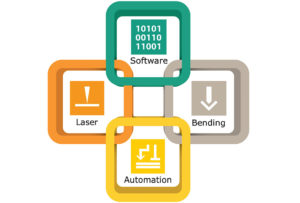 Fiber laser cutting technology has truly become a revolutionary change and not an evolutionary change. The prior revolutionary change in laser cutting began with the introduction of CO2 laser processing of materials, which over time has only experienced an evolutionary change with higher laser powers and new cutting capabilities.
Fiber laser cutting technology has truly become a revolutionary change and not an evolutionary change. The prior revolutionary change in laser cutting began with the introduction of CO2 laser processing of materials, which over time has only experienced an evolutionary change with higher laser powers and new cutting capabilities.
Fiber laser cutting technology has fundamentally changed the sheet metal fabrication industry once again, as anyone that has made the leap from CO2 to Fiber laser technology can attest to. The revolutionary change not only comes from the higher productivity and throughput from fiber laser cutting technology, but also how all of the supporting processes are also affected both before and after the Fiber laser. Another byproduct of this change comes in the ability to radically lower the cost per part and produce higher profit margins as compared with CO2 technology.
Efficiency at the Front End
Fiber laser cutting technology is capable of cutting up to five times faster than CO2 depending on laser power, and also capable of producing up to two to four times more parts per unit of time. With that in mind, it is easy to see how both upstream and downstream processes are affected by the higher productivity and throughput of the fiber laser cutter.
In order to take full advantage of fiber laser cutting technology, order input on the ERP side needs to be efficient so that the production planning and material planning systems can effectively output the orders and prepare the materials for processing. Once the order is received at the order management system, the system can automatically separate the parts by their material type, thickness and due dates. As the parts accumulate from all orders a much higher effective material utilization can be realized when many different parts are used to calculate the best possible material yield. These systems can also process orders as they are received and produce the nests immediately.
Efficiency with Material Handling
Once the nests are completed the next step is to make sure that materials are available for processing on the Fiber laser cutter. The program can be sent electronically to the machine with the embedded material requirements. The most efficient way to manage the raw materials so that they are always at the ready is to have material storage capabilities at the laser along with an automated material load and unload capability. Automating the load and unload process is the key to maintaining the high pace as required by the Fiber laser to unload the cut sheet and load a raw sheet in the same time that the machine is cutting the active sheet. If the machine has to wait for material then the process becomes inefficient.
Efficiency at the Press Brake
Managing the cut parts that will be sent to the bending process is the next step. Once the order arrives at the press brake, the bending system must be able to process the orders effectively without too many parts accumulating at the press brake. For this reason it is best to utilize a press brake with offline programming capabilities and features such as high speed ram positioning, quick change tooling; and dynamic crowning in the case of larger brakes. Reducing the set-up time is critical to managing the throughput at the press brake. Not managing the bending process correctly can lead to a major bottleneck for further downstream processes.
Planning and Managing
Effectively utilizing the speed benefits from high power fiber lasers takes careful planning and management of all processes. With a two to four times greater throughput and a cost of operation that is half of the CO2 laser, the financial gains can be game changing. The results are a lower cost per part, higher potential profit margins and shorter return on investment time. Let’s not forget the added benefit of increased machine capacity now that you are processing your normal part volumes much faster, now providing the opportunity to take on additional work to further increase your sales revenue and profits, not to mention shorter delivery times.
By Frank Arteaga, Head of Product Marketing, NAFTA Region
Bystronic Inc., Elgin, IL – Voice.bystronic@bystronic.com
